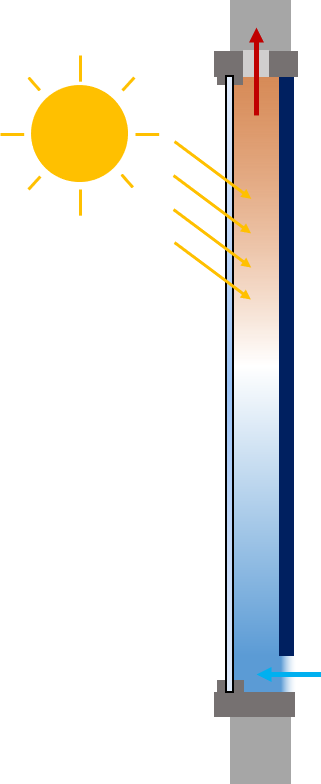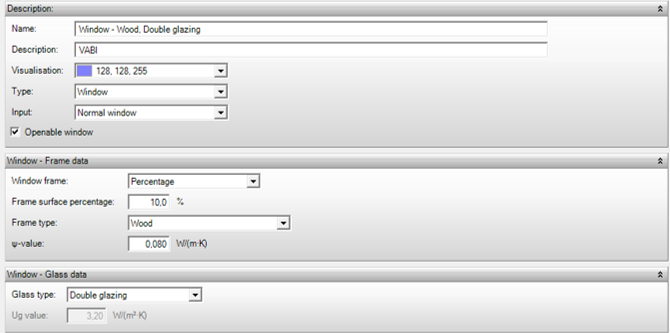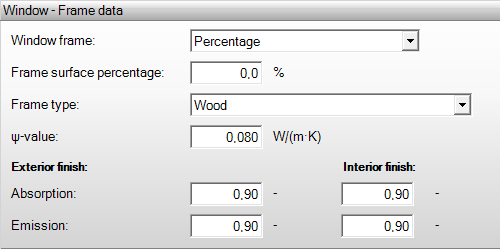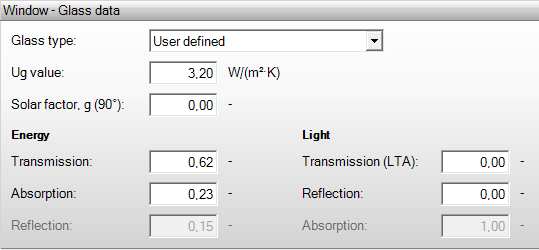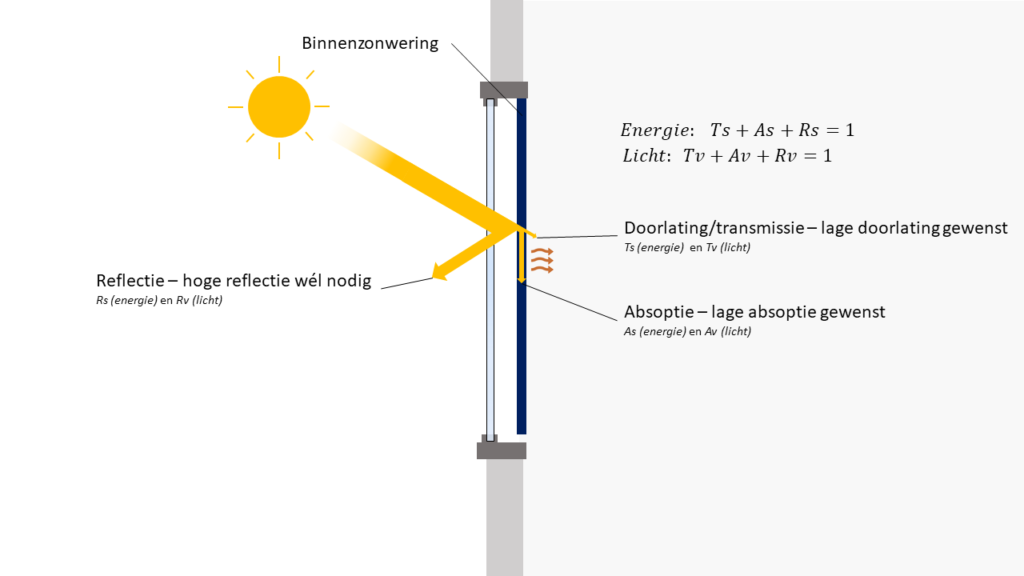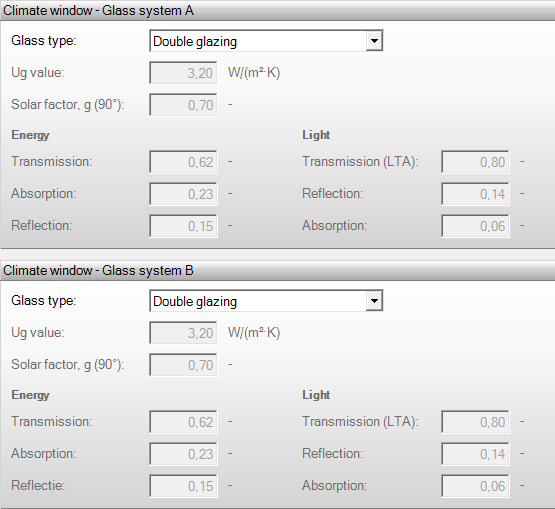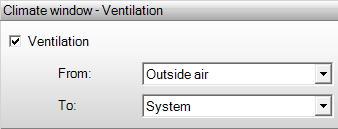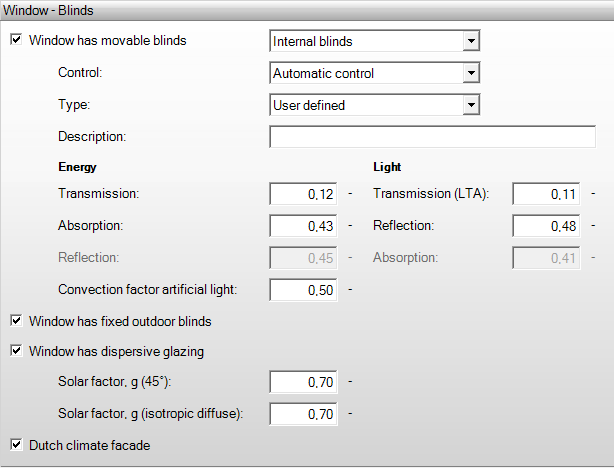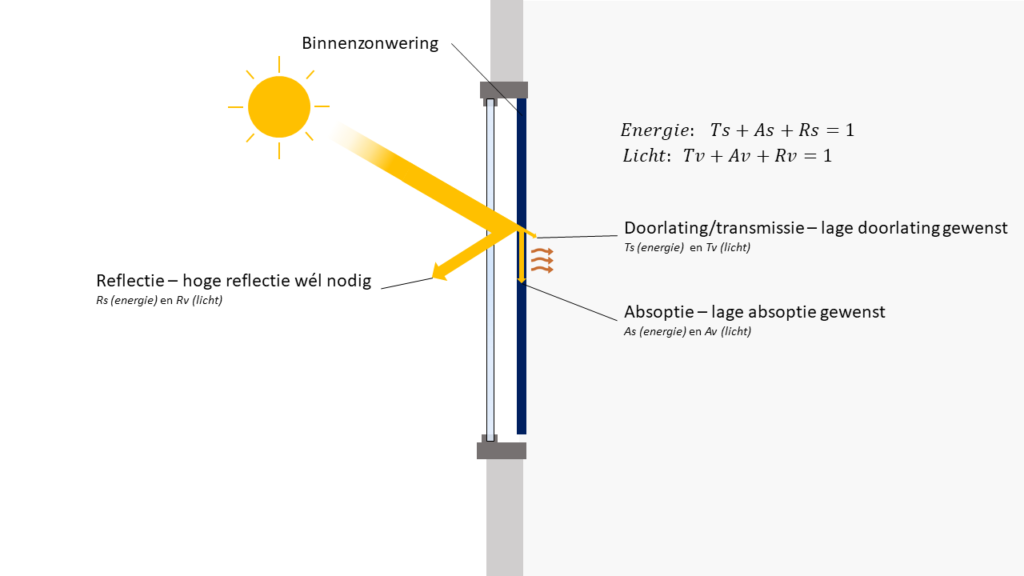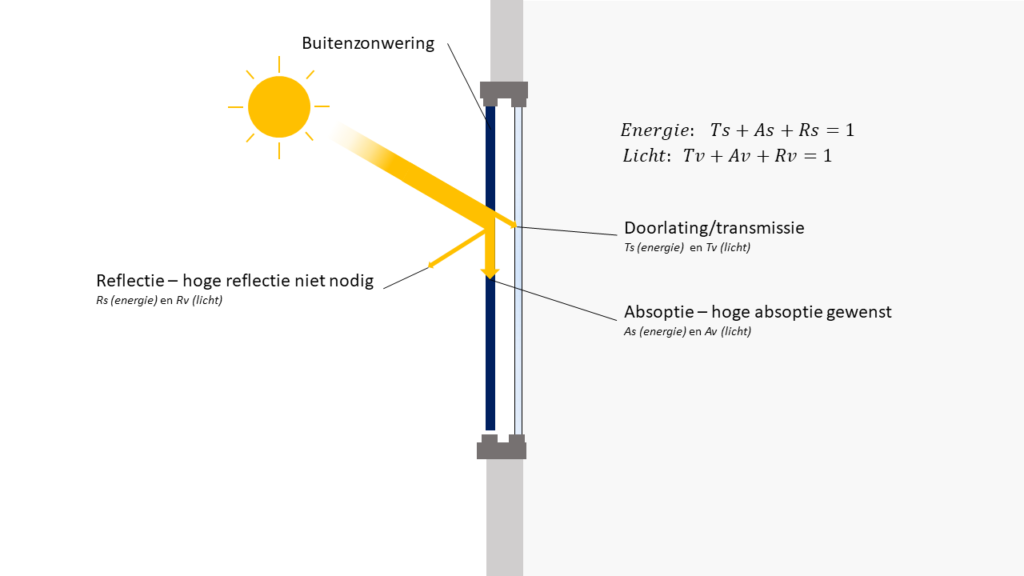Constructions (transparant)
Description
Openable window
- Warmteverlies
The heatloss calculation defines de capacity off the infiltration. ISSO 53 and ISSO 57 divide the infiltration over the rooms based on the openable windows.
Frame data
Frame
- Gebouwsimulatie
- Warmteverlies
- Koellast
- EPG
The frame is the part of the total window area that contains a frame, expressed in frame percentage (%) or frame thickness (mm).
- The frame percentage (default 5%) is the percentage of frame area relative to the total window area;
- The frame thickness (default 67 mm), or frame width of the window frame, is the gross width of the frame edge. Based on this input width, Vabi Elements calculates the frame area considering a single frame around the window. Transoms and mullions are therefore not included in the calculation. If transoms and mullions need to be included in the calculation, we recommend manually calculating the frame percentage.
| Houses | ||
| Window area [m²] | Glass percentage [%] | |
| Metal frame | Wooden or plastic frame | |
| 0,5 | 70 | 65 |
| 0,75 | 75 | 70 |
| 1,0 | 80 | 85 |
| 1,5 | 84 | 89 |
| 2,0 | 86 | 90 |
| 2,5 | 87,5 | 92 |
| 3 and bigger | 88,5 | 93 |
| Utilitity | ||
| Window area [m²] | Glass percentage [%] | |
| With opening windows | 70 | |
| Without opening windows | 85 | |
Publications
Cooling load due to solar heat gain through windows
Glass surface area and window surface area
Frame type
- Gebouwsimulatie
- Warmteverlies
- Koellast
- EPG
Here you define a U-value of a window frame based on a selected standard window type according to ISSO 8, table 7. If you know the U-value yourself, you can enter it directly.
| Frame type | U-value frame (W/m².K) |
| Wood | 2,4 |
| Plastic | 2,0 |
| Metal | 5,9 |
| Metal with thermal barrier | 3,8 |
U-value frame
- Gebouwsimulatie
- Warmteverlies
- Koellast
- EPG
This is the heat transfer coefficient (U-value) of the window frame. A well-insulated frame has the lowest possible U-value.
Ψ-value
- Gebouwsimulatie
- Warmteverlies
- Koellast
- EPG
The PSI-value is the linear thermal bridge between the glass and the frame. This linear thermal bridge is calculated around the perimeter of the glass, which is the perimeter of the window minus the thickness of the frame. A well-insulated frame has the lowest possible PSI-value.
Publications
Linear thermal transmittance coefficient of the glazing edge (EPG)
Absorption
- Gebouwsimulatie
- Koellast
Absorption is the heat or cold that a surface of a construction can absorb relative to its specific heat capacity. This property depends, for example, on the surface finish such as color and coating, and the type of material. Absorption applies to shortwave solar radiation. Emission concerns longwave radiation. Therefore, absorption and emission do not need to be equal. Metal surfaces generally have a lower value.
Emission
- Gebouwsimulatie
Emission is the heat or cold that a surface of a construction can emit to its surroundings relative to its specific heat capacity. This property depends, for example, on the type of material. Emission concerns longwave radiation. Absorption applies to shortwave solar radiation. Therefore, these do not need to be equal.
Glass data
Glass type
- Gebouwsimulatie
- Warmteverlies
- Koellast
- EPG
This choice includes preset glass data such as U-value (Ug), solar heat gain coefficient (g-value), absorption, transmittance, LTA (Light Transmittance and Absorbance), and reflection for commonly used glazing types. If you have specific glass data, you can enter your own values. Make sure to enter factors rather than percentages in Vabi Elements.
Publications
(Building simulation) Basis assumptions for temperature simulation calculations, physical material data
U-waarde of warmtedoorgangscoëfficiënt of warmtedoorgangscoëfficiënt
Calumen® II
Client Applications, Glass Configurator II
U
- Gebouwsimulatie
- Warmteverlies
- Koellast
- EPG
The U-value (Ug) is the heat transfer coefficient of the glass. It represents the rate of heat transfer in Watts per unit area per degree Kelvin temperature difference between the inside and outside of the glass. This thermal property should be measured perpendicular to the surface, according to NEN-EN 673:2011. Well-insulated glass has the lowest possible U-value.
g-value (ggl;n)
- Gebouwsimulatie
- Koellast
- EPG
The solar heat gain coefficient (g-value or g-factor) is the solar factor and indicates the ratio between the incoming and incident solar radiation. It is a product characteristic of a glass system and measures the total amount of solar energy transmitted through the glass system in the form of shortwave radiation, longwave radiation, and convective heat transfer. The value ranges between 0 and 1. A higher g-value means more heat enters the building.
This glass property should be measured according to NEN-EN 410:2011, and it represents solar transmittance under perpendicular incidence.
Note that the SHGC (Solar Heat Gain Coefficient) in many cases differs from the g-value of glass. In the Netherlands, SHGC was used to indicate how much solar radiation could enter through the glass. Internationally, SHGC is not used; instead, the g-value of glass is used.
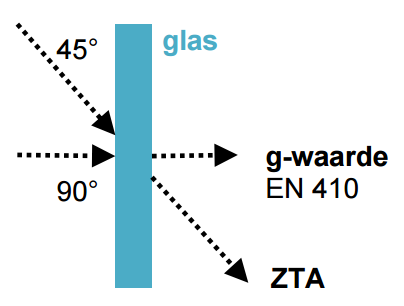
1. ZTA (=SHGC), This value applies at an angle of incidence of 45 degrees.
2. ggl;n, This value applies at an angle of incidence of 90°, perpendicular to the glass. This value is prescribed by the European standard EN 410.
The ggl;n is always higher than ZTA, because solar ingress perpendicular to the glass gives less reflection. Vabi Elements Building Simulation corrects the values for the entire year with the actual sun positions and the corresponding reflection.
Also, the new Dutch calculation standards no longer ask for ZTA, but for the g-value (ggl;n). This aligns the input of glass data more closely with international standards and methodologies, allowing the glass data from manufacturers to be entered more accurately.
For example: According to NEN 7120, the EPG calculates the g-value converted to ggl, which is equivalent to ZTA, using formula NEN 7120 section 11.7.2: ggl = Fw x ggl;n where Fw = 0.9, and ggl is rounded down to the nearest multiple of 0.05. Therefore, in the EPG, the ZTA is 0.05-0.10 lower than the specified g-value.
Foreign terms are: solar radiant heat total transmission (English), gesamt-energie-durchlassigkeit (German), facteur solaire (French). Solar Heat Gain Coefficient (SHGC, equivalent to the g-value for standard air density) is also used. This value has replaced the Shading Coefficient (SC). To convert SC to SHGC, the following formula can be used:
SHGC = SC * 0.87
Transmission energy
- Gebouwsimulatie
- Koellast
This is the direct energy transmission [αe, TE%] and indicates the percentage of energy that passes through the glass. It represents the portion of directly transmitted solar energy, in other words, transmitted solar radiation compared to the total incident solar radiation. The higher the τe value, the more light is transmitted. This glass property should be measured according to NEN-EN 410:2011.
Absorption energy
- Gebouwsimulatie
- Koellast
Energy absorption [αe, AE1% + AE2%] is the portion of solar energy absorbed by the glass. This glass property should be measured according to NEN-EN 410:2011. The higher the absorption, the more energy is absorbed.
Reflection energy
- Gebouwsimulatie
- Koellast
Energy reflection is the percentage of energy that is reflected by the glass. The higher the reflection, the more energy is reflected.
τe + αe + ρe = 1
This formula states that the sum of transmittance, absorption, and reflection coefficients equals 1.
Transmission light (LTA)
- Gebouwsimulatie
- Koellast
This is the light transmittance factor [τv, TL%], also known as light transmission, which indicates the ratio of incoming visible solar radiation to the incident visible solar radiation at a perpendicular angle. This coefficient is used to determine the light entering a space and is used for controlling lighting. The higher the LTA value, the more visible light and heat enter. This glass property should be measured according to NEN-EN 410:2011.
Reflection light
- Gebouwsimulatie
- Koellast
Visible reflectance [ρv, RLe%], or visible light reflectance, indicates the percentage of visible light that is reflected by the glass. The higher the reflectance, the more light is reflected. This glass property should be measured according to NEN-EN 410:2011.
Absorption light
- Gebouwsimulatie
- Koellast
Light absorption is the portion of light absorbed by the glass. The higher the absorption, the more light is absorbed.
Climate window
Climate window heat loss
- Warmteverlies
From ISSO 2024 it’s possible, for non-residential buildings, to make a heatloss calculation with Climate windows.
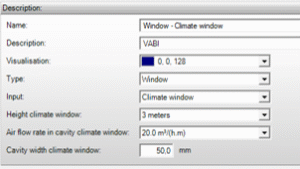
The boxes are only for heat loss.
The temperature between the glass is calculated. Transmission is calculated based on the temperature differance between the room and the temperature between the glass.
The U-value is according to the inside glass; par 2.5.1 ISSO 53.
Climate window Building simulation
- Gebouwsimulatie
For a climate window, you specify the glass data for both the internal and external glass systems.
A climate window consists of two panes with a ventilated cavity in between, where sun shading can be installed. The ventilated air cools the sun shading, reducing the amount of heat radiated from the sun shading into the interior. In winter, a climate window can be used to warm the window and thereby reduce the cold radiation from the window into the interior. This is only beneficial when there is no heat recovery, as otherwise the air would cool too much to recover heat.
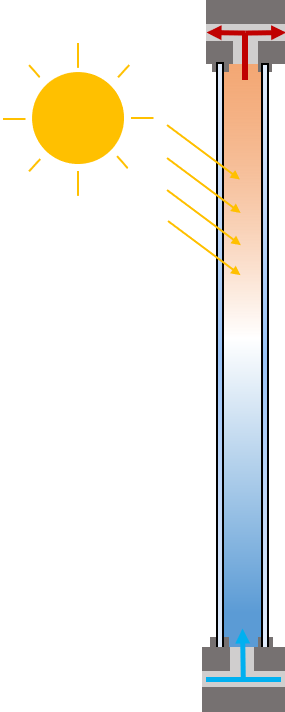
Ventilation
Fill in how the ventilation in the climate window takes place. A climate window is ventilated and this can be done in various ways. It is assumed here that there is complete extraction at the window, because the window is part of the Mechanical Ventilation and Heat Recovery System (MVHR).
Fill in how the ventilation in the climate window takes place. A climate window is ventilated and this can be done in various ways. It is assumed here that there is complete extraction at the window, because the window is part of the Mechanical Ventilation and Heat Recovery System (MVHR).
Ventilation
Fill in whether the climate window is ventilated.
Ventilation from
Source of ventilation air:
- Outside air: the air is supplied from outside.
- Inside air: the air is supplied from inside.
Ventilation to
Where the ventilation air is exhausted:
- Outside air: the air is exhausted to the outside.
- Inside air: the air is exhausted to the inside.
- System: the air is extracted by a local system.
Blinds
Movable blinds
- Gebouwsimulatie
- Koellast
- EPG
Here you choose whether to install controlled sun shading at the window. When you check the box for sun shading, all subsequent settings will appear. This setting applies regardless of whether it concerns a standard window or a climate window.
For the placement, you have the following options:
- External blinds: External sun shading installed outside the window, such as screens.
- Blinds between panes: Sun shading installed inside or between the window, such as blinds.
- Internal blinds: Sun shading installed on the inside of the window.
For sun shading, the most important factor is the transmission of energy, or transmittance. In good sun shading, this value will be low, whereas in poor sun shading, it will be high. There is also a difference between indoor and outdoor sun shading.
For indoor sun shading, the level of reflection is crucial. A higher reflection reduces the transmission of energy. High absorption is not desirable for indoor sun shading because it creates large radiant surfaces.
In contrast, absorption is less critical for outdoor sun shading because absorbed heat does not radiate indoors. Therefore, the absorption value can be higher for outdoor sun shading compared to indoor, where a high absorption is undesirable.
Publications
Appendix E: Network view of common window systems
Control
- Gebouwsimulatie
- Koellast
The control provides an option for how the sun shading is regulated. You can then define this choice under the sun shading switching level in the building template building controls.
- Manual: The sun shading is manually controlled. Depending on the setting under Building Controls, it can either be continuously open, continuously closed, or controlled via a specific switching level.
- Automatic: The sun shading is automatically controlled. Depending on the setting under Building Controls, it can either be continuously open, continuously closed, or controlled via a specific switching level.
Type
Fill in the type of sun protection here. There is a difference between indoor and outdoor/ between sun protection. You can choose from the following types:
External blinds and blinds between panes
| Energy | Good | Moderate | Bad |
| Transmission ts | 0.03 | 0.12 | 0.19 |
| Absorption as | 0.92 | 0.43 | 0.14 |
| Reflection rs | 0.05 | 0.45 | 0.67 |
| Licht | |||
| Transmission (LTA) tv | 0.03 | 0.11 | 0.19 |
| Reflection rv | 0.05 | 0.48 | 0.76 |
| Absorption av | 0.92 | 0.41 | 0.05 |
Internal blinds
| Energie | Goed | Matig | Slecht |
| Doorlating | 0.05 | 0.05 | 0.10 |
| Absorptie | 0.20 | 0.52 | 0.81 |
| Reflectie | 0.75 | 0.43 | 0.09 |
| Licht | |||
| Doorlating (LTA) | 0.06 | 0.04 | 0.10 |
| Reflectie | 0.74 | 0.42 | 0.09 |
| Absorptie | 0.20 | 0.54 | 0.81 |
Creation of blind values
In collaboration with blinds suppliers, standard blinds types have been determined that you can choose from: poor, moderate, or good. The current market values have been applied to these categories as specifications. The order from good to poor is based on the g-value in combination with HR++ glass. The g-value indicates the ratio between the incoming solar radiation and the transmitted solar radiation. The lower the g-value, the less solar heat enters the building.
Type of blinds: User defined
In collaboration with blinds suppliers, standard blinds types have been determined that you can choose from: poor, moderate, or good. The current market values have been applied to these categories as specifications. The order from good to poor is based on the g-value in combination with HR++ glass. The g-value indicates the ratio between the incoming solar radiation and the transmitted solar radiation. The lower the g-value, the less solar heat enters the building.
Voor zonwering kan je Eigen waarden voor de doorlating, absorptie en reflectie voor energie en zichtbare licht invullen. In onderstaande tabel geven we aan hoe je de Fc waardes van de NTA8800 in kan vullen in Elements. Deze waarden kunnen ook als leidraad dienen voor als je het type zonwering weet, maar niet welke doorlating, absorptie en reflectie waardes hierbij horen.
For blinds, you can enter your own values for transmission, absorption, and reflection for energy and visible light. In the table below, we indicate how to fill in the Fc values from the NTA8800 in Elements. These values can also serve as a guideline if you know the type of sun protection but not the corresponding transmission, absorption, and reflection values.
FC value
The FC value is a combination of the properties of the window and the properties of the blinds. The FC value from Vabi EPA is equal to the g-value of the composite glass with sun protection divided by the g-value of the glass alone (see also NTA 8800 – formula 7.43).
In the table below, you can find what you can enter in Vabi Elements for HR++ glass to achieve the correct FC value.
| Type of blinds | Color | criteria | Fc | Energy | Light | G glass | G tot | Fc | |||||
| Ts | Rs | D | A | R | D | A | R | ||||||
| Screens | zwart | <0.07 | 0.12 | 0.10 | 0.88 | 0.02 | 0.03 | 0.92 | 0.05 | 0.58 | 0.071 | 0.12 | |
| overig | <0.17 | 0.20 | 0.17 | 0.38 | 0.45 | 0.11 | 0.41 | 0.48 | 0.58 | 0.117 | 0.20 | ||
| wit | >=0.17 | 0.25 | 0.21 | 0.12 | 0.67 | 0.19 | 0.05 | 0.76 | 0.58 | 0.147 | 0.25 | ||
| Blinds | zwart | <0.3 | 0.05 | 0.03 | 0.92 | 0.05 | 0.03 | 0.92 | 0.05 | 0.58 | 0.03 | 0.05 | |
| overig | <0.6 | 0.10 | 0.08 | 0.43 | 0.49 | 0.11 | 0.41 | 0.48 | 0.58 | 0.059 | 0.10 | ||
| wit | >=0,6 | 0.20 | 0.16 | 0.14 | 0.7 | 0.19 | 0.05 | 0.76 | 0.58 | 0.114 | 0.20 | ||
| Roller shutters | overig | <0.70 | 0.11 | 0.09 | 0.43 | 0.48 | 0.11 | 0.41 | 0.48 | 0.58 | 0.065 | 0.11 | |
| wit | >0.70 | 0.04 | 0.03 | 0.20 | 0.76 | 0.19 | 0.05 | 0.76 | 0.58 | 0.024 | 0.04 | ||
| Metallized fabrics, indoor | >0.72 | 0.45 | 0.05 | 0.13 | 0.82 | 0.06 | 0.20 | 0.74 | 0.58 | 0.263 | 0.45 | ||
| Drop arm awnings | 0.35 | 0.30 | 0.14 | 0.56 | 0.19 | 0.05 | 0.76 | 0.58 | 0.204 | 0.35 | |||
| 0.45 | 0.39 | 0.14 | 0.47 | 0.19 | 0.05 | 0.76 | 0.58 | 0.259 | 0.45 | ||||
| 0.50 | 0.44 | 0.14 | 0.42 | 0.19 | 0.05 | 0.76 | 0.58 | 0.288 | 0.50 | ||||
| 0.55 | 0.49 | 0.14 | 0.37 | 0.19 | 0.05 | 0.76 | 0.58 | 0.317 | 0.55 | ||||
| 0.65 | 0.60 | 0.14 | 0.26 | 0.19 | 0.05 | 0.76 | 0.58 | 0.377 | 0.60 | ||||
| 0.80 | 0.77 | 0.14 | 0.09 | 0.19 | 0.05 | 0.76 | 0.58 | 0.464 | 0.80 | ||||
| 0.90 | 0.88 | 0.10 | 0.02 | 0.19 | 0.05 | 0.76 | 0.58 | 0.521 | 0.90 | ||||
See also NTA 8800 – Table 7.5 Forfait values for the reduction factor for the total solar transmittance factor, for screens, blinds, and metallized fabrics.
Convective factor artificial lighting
- Koellast
When internal blinds are present, the convective factor artificial lighting can be filled in. The heat radiation from the artificial lighting causes the indoor sun protection to warm up and radiate heat. The impact of the convective factor also depends on the specified lighting power.
Fixed outdoor blinds
- EPG
Fixed external blinds is an option that can only be applied for an EPG calculation. It concerns external sun protection that is always present. For fixed blinds (as well as for diffusing glazing), the time-averaged solar heat gain factor \( g_{gl} \) is used, which is calculated from the specified g-value at a solar altitude of 45º and the g-value for isotropic diffuse solar radiation.
Dispersive glazing
- EPG
Dispersive glazing is an option that can only be applied for an EPG calculation. For dispersive glazing, the time-averaged solar heat gain factor \( g_{gl} \) is used, which is calculated from the specified g-value at a solar altitude of 45º and the g-value for isotropic diffuse solar radiation.
Solar factor. g (45º)
The g-value of the glass is determined at a solar altitude of 45º. This value can be specified if fixed external blinds or diffusing glazing is chosen, and it is used for the calculation of the \( g_{gl} \) value.
Solar factor. g (isotropic diffuse)
The g-value for isotropic diffuse solar radiation is determined according to ISO 15099. This value can be specified if fixed external sun protection or diffusing glazing is chosen, and it is used for the calculation of the \( g_{gl} \) value.
Publication
Daylight aperture solar factor
Dutch climate facade
Indicate whether a Dutch climate facade is present. In a Dutch climate facade, air is extracted between the interior sun protection and the glass. This reduces the amount of heat entering the space. The ventilation is part of the mechanical ventilation system (LBK) and cannot be combined with natural ventilation.
A more maintenance-friendly variant of the Climate Window is the Dutch climate facade. Instead of two windows, sun protection is installed on the inside of the glass and air is extracted between the sun protection and the glass. This air cools the sun protection, reducing the amount of heat radiated into the room.
In Vabi Elements, you can select the Dutch climate facade when interior sun protection is present. Full extraction will also be assumed for the Dutch climate facade at the window.
